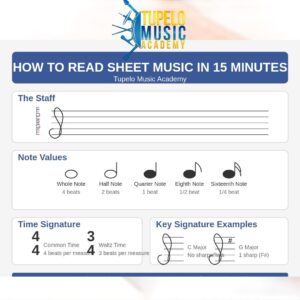Learning to read music doesn’t have to take months or years. At Tupelo Music Academy, we believe in making music accessible to everyone. This quick guide will have you understanding the basics of sheet music in just 15 minutes!
The Staff: Your Musical Canvas
The staff is the foundation of sheet music – five horizontal lines and four spaces where notes are placed. Each line and space represents a different musical pitch.
Quick Tip: Remember the lines in treble clef with the phrase “Every Good Boy Does Fine” (E, G, B, D, F from bottom to top). The spaces spell “FACE.”
Meet the Clefs: Your Musical Guides
The two most common clefs are:
- Treble Clef (G Clef): Used for higher-pitched instruments and typically the right hand in piano music.
- Bass Clef (F Clef): Used for lower-pitched instruments and the left hand in piano music.
Quick Tip: The treble clef circles around the G line, while the bass clef’s two dots surround the F line.
Notes and Their Values: The Building Blocks
Notes tell you both the pitch (how high or low) and duration (how long to play):
- Whole note (o): Play for 4 beats
- Half note (𝅗𝅥): Play for 2 beats
- Quarter note (♩): Play for 1 beat
- Eighth note (♪): Play for 1/2 beat
- Sixteenth note (𝅘𝅥𝅯): Play for 1/4 beat
Quick Tip: Each note value is half the duration of the one before it.
Time Signatures: The Musical Clock
The time signature (looks like a fraction) tells you how many beats are in each measure and what note gets one beat.
- 4/4: The most common time signature. 4 beats per measure, quarter note gets one beat.
- 3/4: Waltz time. 3 beats per measure, quarter note gets one beat.
Quick Tip: The top number tells you beats per measure; the bottom number tells you which note value equals one beat.
Sharps, Flats, and Naturals: The Modifiers
- Sharp (#): Raises a note by a half step
- Flat (♭): Lowers a note by a half step
- Natural (♮): Cancels previous sharps or flats
Quick Tip: Think of a sharp as moving “up” to the next key (including black keys on a piano) and a flat as moving “down.”
Key Signatures: The Musical Roadmap
Key signatures are the sharps or flats at the beginning of a staff that tell you which notes are consistently sharp or flat throughout the piece.
Quick Tip: For beginners, C major (no sharps or flats) is the easiest key to start with.
Rests: The Silence in Music
Rests indicate when not to play and for how long to remain silent:
- Whole rest: 4 beats of silence
- Half rest: 2 beats of silence
- Quarter rest: 1 beat of silence
- Eighth rest: 1/2 beat of silence
Quick Tip: Rests look different from notes but follow the same timing patterns.
Dynamics: The Volume Control
Dynamics tell you how loud or soft to play:
- pp (pianissimo): Very soft
- p (piano): Soft
- mp (mezzo piano): Moderately soft
- mf (mezzo forte): Moderately loud
- f (forte): Loud
- ff (fortissimo): Very loud
Quick Tip: The more p’s or f’s, the softer or louder the music.
Tempo: The Speed Setting
Tempo markings (often in Italian) indicate how fast or slow to play:
- Allegro: Fast, lively
- Andante: Moderate, walking pace
- Adagio: Slow, at ease
Quick Tip: Many modern sheet music also includes BPM (beats per minute) numbers for precise tempo.
Putting It All Together: Your 15-Minute Achievement
Now that you know the basic elements, here’s how to approach reading a simple piece:
- Identify the clef and key signature
- Check the time signature
- Start reading from left to right, one measure at a time
- Note the pitch (position on staff) and duration (note value) of each note
- Pay attention to dynamics and tempo markings
Quick Tip from Tupelo Music Academy: Start with simple pieces like “Mary Had a Little Lamb” or “Twinkle, Twinkle Little Star” to practice these concepts.
Next Steps: Beyond the Basics
Congratulations! You now understand the fundamental building blocks of sheet music. With just 15 minutes of learning, you have the tools to start decoding simple melodies.
Want to deepen your knowledge and develop your skills further? Tupelo Music Academy offers personalized lessons for all ages and skill levels. Our experienced teachers will guide you from these basics to advanced musical proficiency at your own pace.
Visit us www.tupelomusicacademy.com or call us at (662) 397-1632 to schedule your first lesson today. Mention this article for a free 30-minute consultation with one of our instructors!
Additional Resources
- Download our free Tupelo Music Academy Note Reading Flashcards
- Subscribe to our YouTube channel for weekly music theory tutorials
- Join our community of music learners in our Facebook Page Tupelo Music Academy
Remember, every great musician started as a beginner.
At Tupelo Music Academy, we believe everyone has musical potential waiting to be unlocked!
Terrence
The Music Master 
